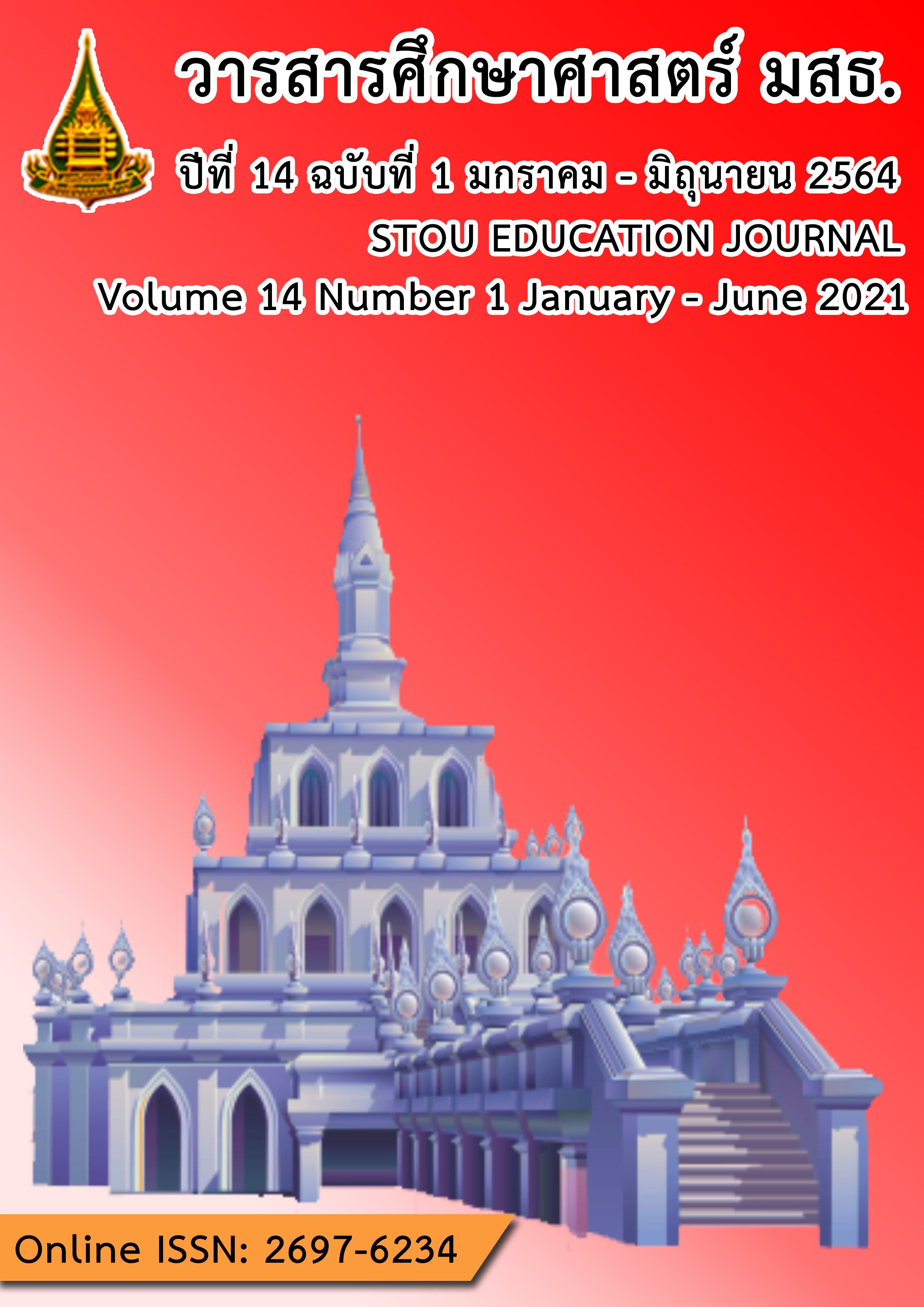Learning Management Using Mathematical Models of Learners in Mathematics Problem Solving
Main Article Content
Abstract
Mathematical model as a mathematical teaching goal is the basic ability for learners to solve problems and apply to other disciplines. Currently, learning management in Thailand does not encourage students to solve the problems by themselves. This research aimed to study learning management practices using mathematical models of learners to solve mathematical problems. The target group was 16 second-year students majoring in Electrical Engineering in the first semester of the academic year 2020 at the Faculty of Engineering and Architecture Rajamangala, University of Technology Suvarnabhumi, Suphanburi Center, who enrolled in the calculus 2: polar coordinate system. The research instrument was the learning management plan: polar coordinates system, field note, interview, and reflective learning management. Data was analyzed by content analysis. The results showed that learning management using mathematical models of learners to solve mathematical problems should emphasize that students use the previous learning method with four steps: step 1: learners present mathematical problems by discussing together to plan solutions, step 2: solves problems based on a group process with teachers supporting each student’s problem solving, step 3: rational discussion and comparison of ideas in the math classroom, and step 4: summarizing to connect the mathematical concepts in the math classroom.
Article Details
References
คณะกรรมการการศึกษาแห่งชาติ. (2543). ก้าวสู่สหัสวรรษใหม่ เด็กไทยเรียนรู้อย่างมีความสุข. กรุงเทพฯ: วีทีซีคอมมิวนิเคชั่น.
ปรีชา เนาว์เย็นผล. (2544). การสอนคณิตศาสตร์โดยใช้การแก้ปัญหาปลายเปิดสำหรับนักเรียนชั้นมัธยมศึกษาปีที่ 1. (วิทยานิพนธ์ครุศาสตรดุษฎีบัณฑิต ไม่ได้ตีพิมพ์). มหาวิทยาลัยศรีนครินทรวิโรฒ, กรุงเทพฯ.
พงศกร วังศิลา, วนินทร สุภาพ, จักรกฤษ กลิ่นเอี่ยม. (2563). การศึกษาการใช้แบบจำลองทางคณิตศาสตร์ที่ส่งเสริมความคิดสร้างสรรค์ทางคณิตศาสตร์เรื่องเรขาคณิตวิเคราะห์ของนักเรียนชั้นมัธยมศึกษาปีที่ 4. วารสารศึกษาศาสตร์ มหาวิทยาลัยนเรศวร, 22(3), 150–163.
วีรพล เทพบรรหาร. (2560). ผลการใช้ตัวแทนทางความคิดและตัวแบบเชิงคณิตศาสตร์ร่วมกับแนวคิดการสอนแนะให้รู้คิดที่มีต่อความสามารถในการให้เหตุผลและความสามารถในการเชื่อมโยงความรู้ทางคณิตศาสตร์ของนักเรียนมัธยมศึกษาตอนต้น (รายงานผลการวิจัย). กรุงเทพฯ: จุฬาลงกรณ์มหาวิทยาลัย.
สิรินภา กิจเกื้อกูล. (2557). การจัดการเรียนรู้วิทยาศาสตร์ทิศทางสำหรับครูศตวรรษที่ 21. เพชรบูรณ์: จุลดิส การพิมพ์.
Blum, W., & Niss, M. (1991). Applied mathematical problem solving, modelling, application, and links to other subjects-state, trends, and issues in mathematics instruction. Educational Studies in Mathematics, 22(1), 37-68.
Blum, W., & Ferri, R. B. (2009). Mathematical modeling: Can it be taught and learnt? Journal of Mathematical Modeling and Application, 1(1), 45–58.
Doerr, H., & Tripp. J. (1999). Understanding how students develop mathematical models. Mathematical Thinking and Learning, 1(3), 231–254.
Ernest, P. (1994). Constructing mathematical knowledge: Epistemology and mathematics education. London: Falmer.
Galbraith, P. (2012). Models of modeling: Genres, purposes or perspectives. Journal of Mathematical Modeling and Application, 1(5), 3-16.
Inprasitha, M. (1997). Problem solving: A basis to reform mathematics instruction. The Journal of the National Research Council of Thailand, 29, 221-259.
Inprasitha, M.(2010). One feature of adaptive lesson study in Thailand: designing learning unit. In Cheong, S. C., Sang, G.L., & Young, H. C. (Eds.). The 45th Korean National Meeting of Mathematics Education. (pp. 193-206). Gyeongju: Dongkook University
Kim, S. H. (2005). Development of the evaluation criterion for mathematically gifted student’s creative product in view of mathematical history. The Korean Journal for History of Mathematics, 18(2), 75–94.
National Research Council [NRC]. (1989). Every body counts: A report to the nation on the future of mathematics education. Washington, DC: National Academy.
National Council of Teachers of Mathematics [NCTM]. (1989). Curriculum and evaluation Standards for school mathematics. Reston, Virginia: NCTM.
National Council of Teachers of Mathematics [NCTM]. (2000). Principles and standards for school mathematics. Reston, Virginia: NCTM.
Polya, G. (1973). How to solve it : A new aspect of mathematical method. Princeton, NJ: Princeton University Press.
Ruangwiset, S. (2006). Mathematics in everyday life. Bangkok: Idea Square.
Schoenfeld, A.H. (1989). Teaching mathematics in elementary school. New York: Ronald Press.
Tall, D. (2007, August). Setting Lesson study in a long term framework for learning. Paper presented at the Conference APEC, Khon Kaen, Thailand.
Tall, D. (2009). Dynamic mathematics and the blending of knowledge structures in the calculus. ZDM–The International Journal on Mathematics Education, 41(4). 481–492.
Thornton, C., & Wilson, S. (1993). Classroom organization and models of instruction. In R. J. Jensen (Ed.). Research Idea for the Classroom: Early Childhood Mathematics. pp.269-293. New York: Macmillm.


